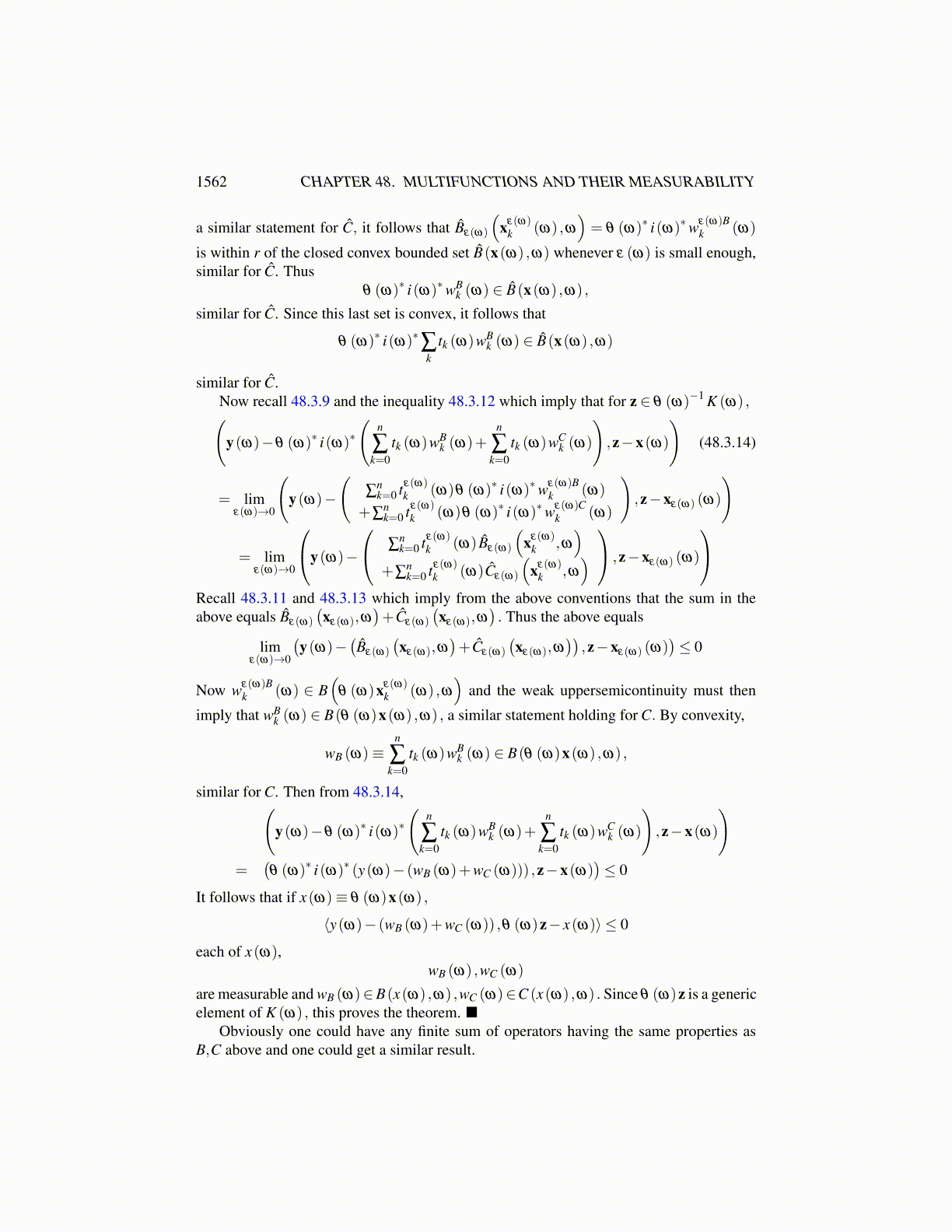
1562 CHAPTER 48. MULTIFUNCTIONS AND THEIR MEASURABILITY
Then (θ (ω)∗ i(ω)∗ z(ω) ,w
)Rn ≡
⟨i(ω)∗ z(ω) ,θ (ω)w
⟩=
⟨i(ω)∗ z(ω) ,∑
iwibi (ω)
⟩
=
⟨z(ω) ,∑
iwibi (ω)
⟩V ′,V
which is measurable. By the Pettis theorem, ω → θ (ω)∗ i(ω)∗ z(ω) is measurable. ThusÂ(·,ω) has the properties claimed.
Now tile Rn with n simplices, each having diameter less than ε < 1, the set of simplicesbeing locally finite. Define for A = B or C the single valued function Âε on all of Rn by thefollowing rule. If
x ∈ [x0, · · · ,xn] ,
so x =∑ni=0 tixi, ti ≥ 0,∑i ti = 1, then let Âε (xk,ω) be a measurable selection from Â(xk,ω)
for each xk a vertex of the simplex. However, we chose Âε (xk,ω) in the obvious way. It isθ (ω)∗ i(ω)∗wεB
k (ω) where wεBk (ω) is a measurable selection of B(θ (ω)xk,ω), measur-
able into V ′ when A = B and θ (ω)∗ i(ω)∗wεCk (ω) where wεC
k (ω)is a measurable selectionof C (θ (ω)xk,ω) , measurable into V ′ when A =C. Then
B̂ε (xk,ω) = θ (ω)∗ i(ω)∗wεBk (ω) , ω → wεB
k (ω) measurable (48.3.10)
with a similar definition holding for Ĉε .Define single valued maps as follows. For x = ∑
ni=0 tixi , ∑i ti = 1, ti ≥ 0, [x0, · · · ,xn] in
the tiling,
B̂ε (x,ω)≡n
∑k=0
tk(B̂ε (xk,ω)
),Ĉε (x,ω)≡
n
∑k=0
tk(Ĉε (xk,ω)
)Âε (x,ω)≡ B̂ε (x,ω)+Ĉε (x,ω) (48.3.11)
Thus Âε (·,ω) is a continuous map defined on Rn thanks to the local finiteness of the tiling,and ω → Âε (x,ω) is measurable.
Let Pθ(ω)−1K(ω)
denote the projection onto the closed convex set θ (ω)−1 K (ω) . Thisis a continuous mapping by Hilbert space considerations. Therefore,
x→ Pθ(ω)−1K(ω)
(y(ω)− Âε (x,ω)+x
)is continuous and by Lemma 48.3.2, ω → P
θ(ω)−1K(ω)
(y(ω)− Âε (x,ω)+x
)is measur-
able, and for each ω, this function of x maps into θ (ω)−1 K (ω) . Therefore by Corollary48.2.14, there exists a fixed point xε (ω) ∈ θ (ω)−1 K (ω) such that ω→ xε (ω) is measur-able and
Pθ(ω)−1K(ω)
(y(ω)−
(B̂ε (xε (ω) ,ω)+Ĉε (xε (ω) ,ω)
)+xε (ω)
)= xε (ω) .